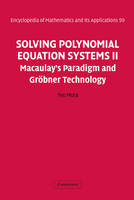
Solving Polynomial Equation Systems II
Macaulay's Paradigm and Gröbner Technology
Seiten
2005
Cambridge University Press (Verlag)
978-0-521-81156-9 (ISBN)
Cambridge University Press (Verlag)
978-0-521-81156-9 (ISBN)
The second volume of this comprehensive treatise focusses on Buchberger theory and its application to the algorithmic view of commutative algebra. Aiming to be a complete survey on Groebner bases and their applications, the book will be essential for all workers in commutative algebra, computational algebra and algebraic geometry.
The second volume of this comprehensive treatise focusses on Buchberger theory and its application to the algorithmic view of commutative algebra. In distinction to other works, the presentation here is based on the intrinsic linear algebra structure of Groebner bases, and thus elementary considerations lead easily to the state-of-the-art in issues of implementation. The same language describes the applications of Groebner technology to the central problems of commutative algebra. The book can be also used as a reference on elementary ideal theory and a source for the state-of-the-art in its algorithmization. Aiming to provide a complete survey on Groebner bases and their applications, the author also includes advanced aspects of Buchberger theory, such as the complexity of the algorithm, Galligo's theorem, the optimality of degrevlex, the Gianni-Kalkbrener theorem, the FGLM algorithm, and so on. Thus it will be essential for all workers in commutative algebra, computational algebra and algebraic geometry.
The second volume of this comprehensive treatise focusses on Buchberger theory and its application to the algorithmic view of commutative algebra. In distinction to other works, the presentation here is based on the intrinsic linear algebra structure of Groebner bases, and thus elementary considerations lead easily to the state-of-the-art in issues of implementation. The same language describes the applications of Groebner technology to the central problems of commutative algebra. The book can be also used as a reference on elementary ideal theory and a source for the state-of-the-art in its algorithmization. Aiming to provide a complete survey on Groebner bases and their applications, the author also includes advanced aspects of Buchberger theory, such as the complexity of the algorithm, Galligo's theorem, the optimality of degrevlex, the Gianni-Kalkbrener theorem, the FGLM algorithm, and so on. Thus it will be essential for all workers in commutative algebra, computational algebra and algebraic geometry.
Preface; Part III. Gauss, Euclid, Buchberger - Elementary Gröbner Bases: 20. Hilbert; 21. Gauss; 22. Buchberger; 23. Macaulay I; 24. Gröbner I; 25. Gebauer and Traverso; 26. Spear; Part IV. Duality: 27. Noether; 28. Möller I; 29. Lazard; 30. Macaulay II; 31. Gröbner II; 32. Gröbner III; 33. Möller II; Part IV. Beyond Dimension Zero: 34. Gröbner IV; 35. Gianni Trager Zacharias; 36. Macaulay III; 37. Galligo; 38. Giusti; Bibliography; Index.
| Erscheint lt. Verlag | 5.5.2005 |
|---|---|
| Reihe/Serie | Encyclopedia of Mathematics and its Applications |
| Verlagsort | Cambridge |
| Sprache | englisch |
| Maße | 165 x 242 mm |
| Gewicht | 1261 g |
| Themenwelt | Mathematik / Informatik ► Mathematik ► Algebra |
| ISBN-10 | 0-521-81156-2 / 0521811562 |
| ISBN-13 | 978-0-521-81156-9 / 9780521811569 |
| Zustand | Neuware |
| Haben Sie eine Frage zum Produkt? |
Mehr entdecken
aus dem Bereich
aus dem Bereich
Buch | Softcover (2022)
Springer Spektrum (Verlag)
CHF 55,95


